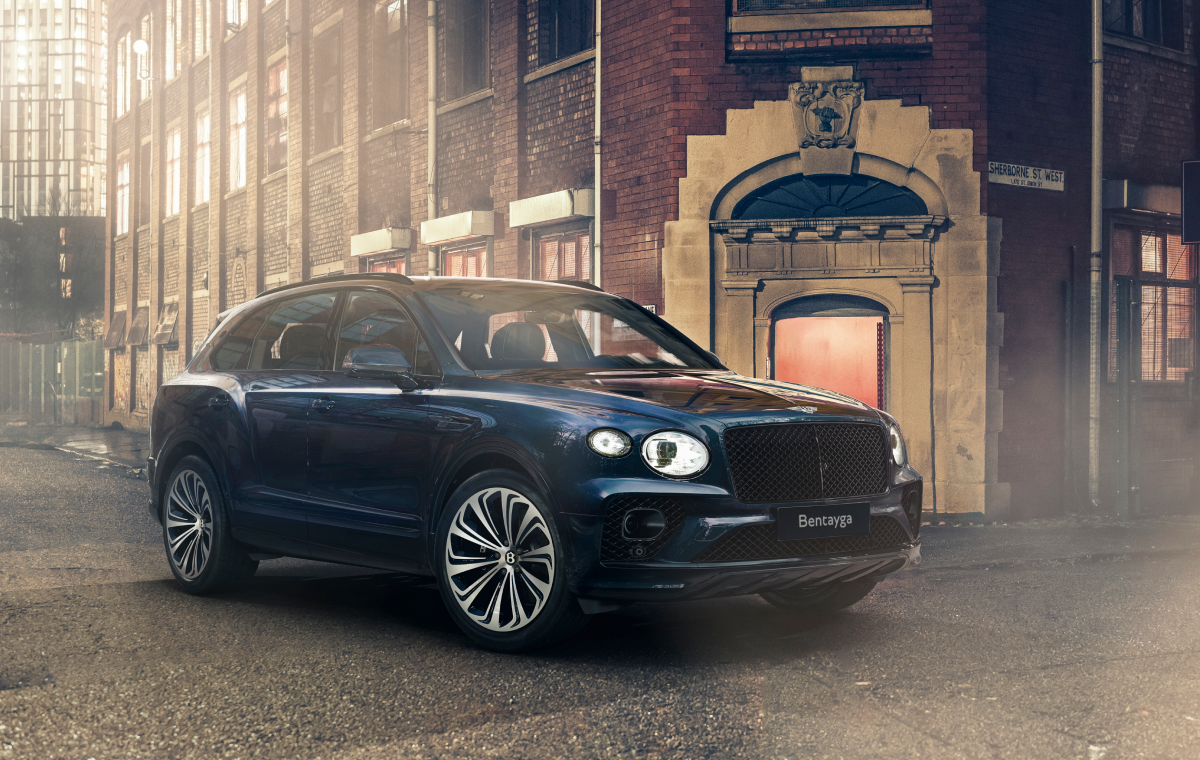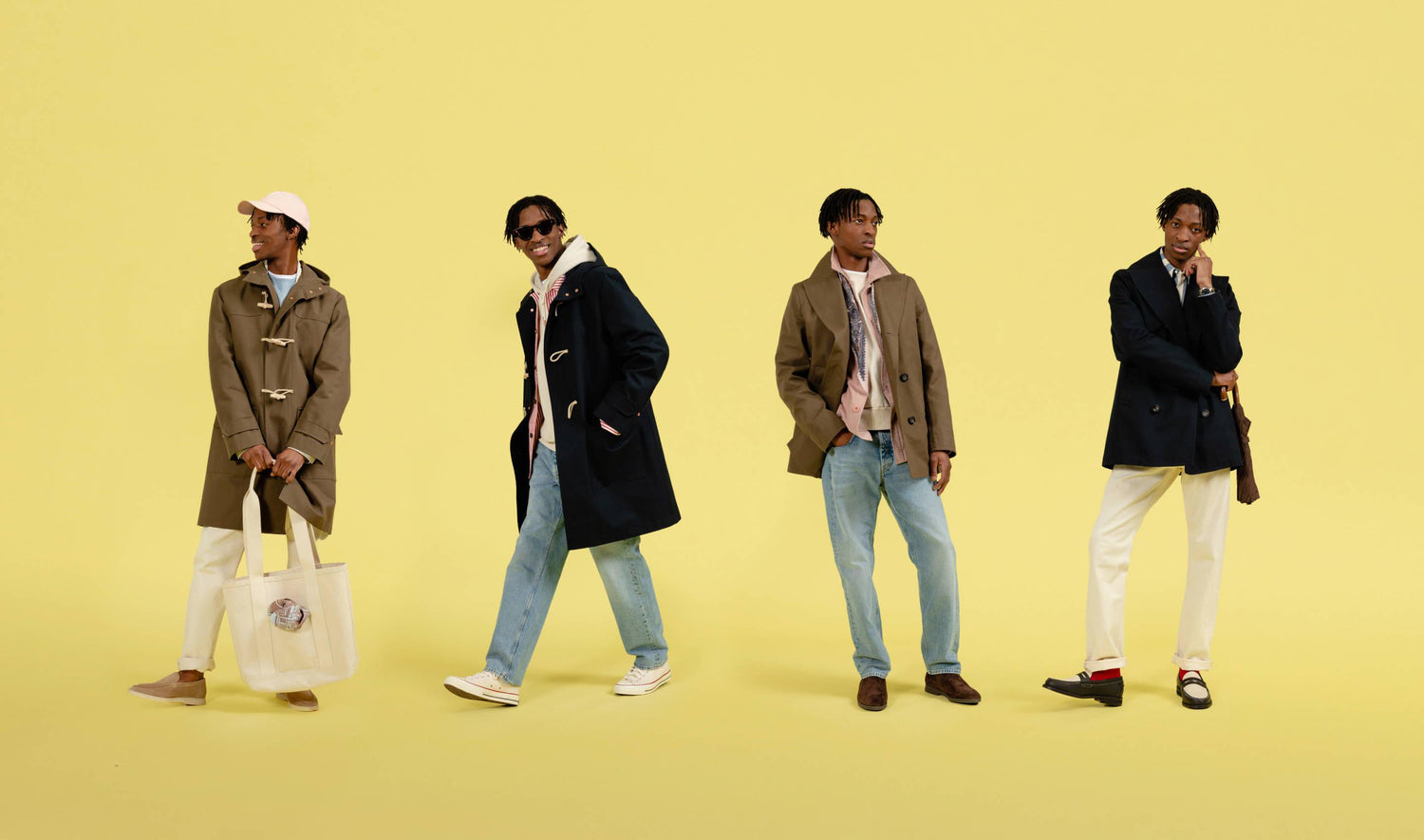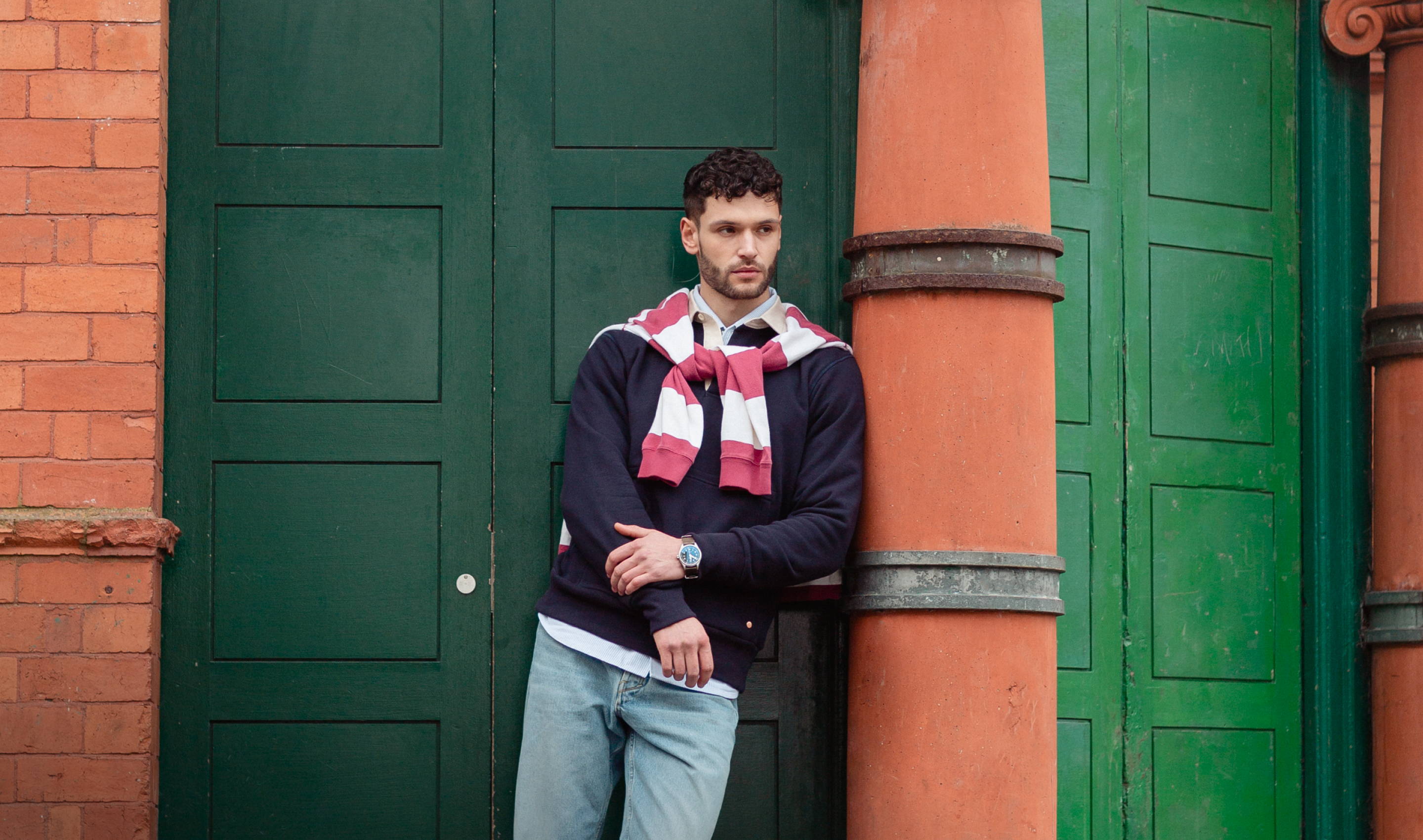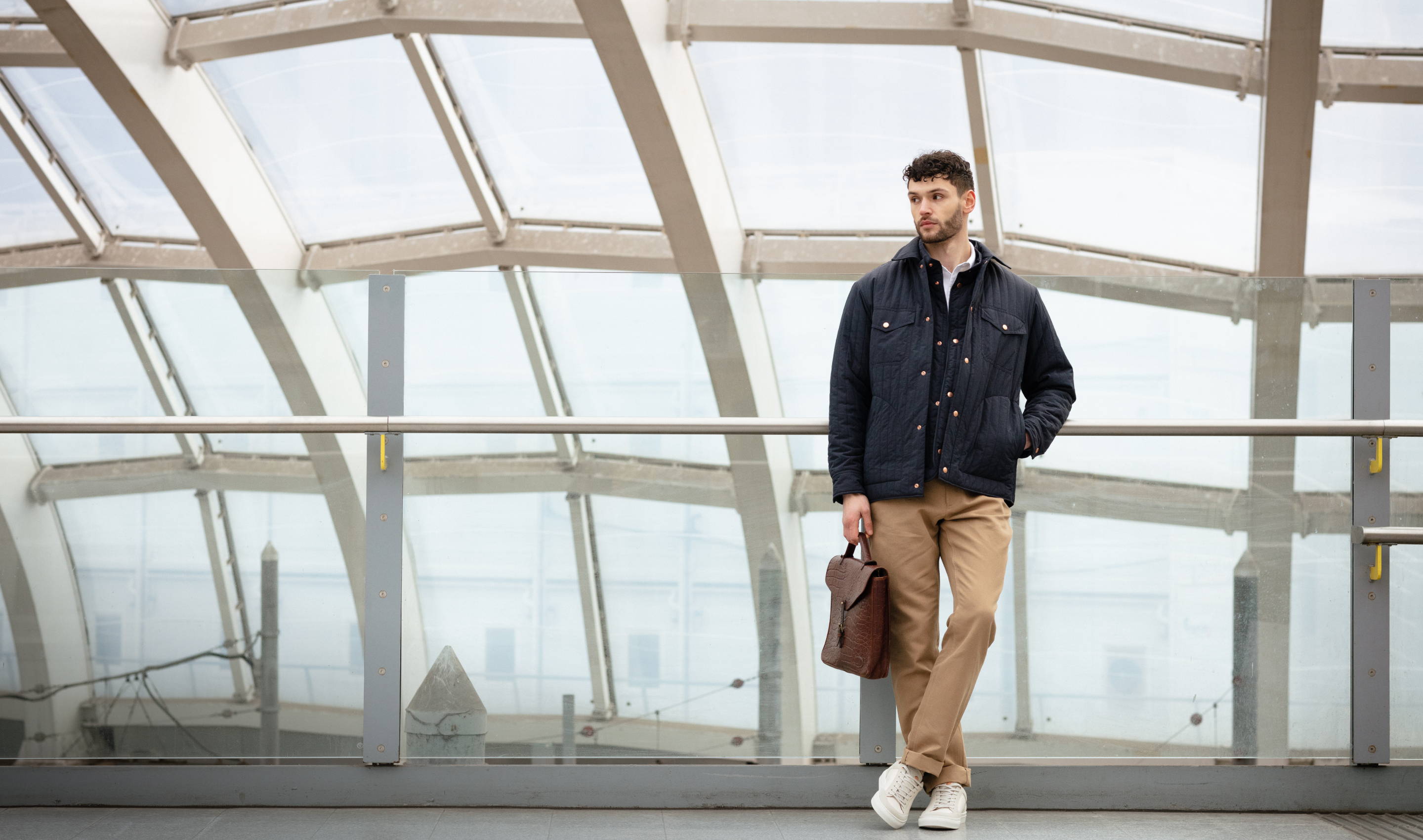It’s no secret that many of the best pieces of outerwear were born out of function. Take the bomber jacket, which first served air force pilots during the First World War, or the chore jacket, which was designed to aid factory workers with its multiple pockets and durable fabric. We’ve been at the forefront of many of these styles, and with our factory producing them for over a century it’s fair to say we know a thing or two about hard-wearing, functional design. We’ve applied our unrivalled knowledge to two of our key jackets for some time: the Peacoat and Duffle. But we’ve now updated these classic silhouettes with a new, lightweight Ventile® canvas fabric, making them perfect for transitional weather.
It’s no secret that many of the best pieces of outerwear were born out of function. Take the bomber jacket, which first served air force pilots during the First World War, or the chore jacket, which was designed to aid factory workers with its multiple pockets and durable fabric. We’ve been at the forefront of many of these styles, and with our factory producing them for over a century it’s fair to say we know a thing or two about hard-wearing, functional design. We’ve applied our unrivalled knowledge to two of our key jackets for some time: the Peacoat and Duffle. But we’ve now updated these classic silhouettes with a new, lightweight Ventile® canvas fabric, making them perfect for transitional weather.
We’ve reengineered these two well-loved pieces of outerwear, transforming them into unlined, breathable and entirely waterproof spring jackets. There’s the Peacoat, with its distinctive double-breasted front, generous lapels and natural, tailored fit; and the Duffle, a nautical icon, with its oversized pockets, long body and large hood having kept sailors dry for generations. Both jackets have been repurposed in a remarkable waterproof cotton canvas, co-developed with Ventile®. The brand is renowned for its innovative approach to fabric design, and this fibre is among its best yet.
Both the Dufflle and the Peacoat have been repurposed from this very Ventile® cotton canvas. It’s a robust, durable fabric that has a similar look to regular canvas - with its attractive, matte textured appearance - except it’s completely waterproof. Put one of these new jackets on and you’ll immediately feel why the fabric is so special. It has a coarse, almost crisp feel at first, in much the same way as a pair of raw selvedge jeans. You might even be tempted to stand the jacket up on its own to see if it can support its own weight. You’ll quickly discover it can’t, but the sturdiness of the fibre hints at how long lasting it’ll be. It’s also entirely recycled.
For this fabric, Ventile® uses pre-consumer cotton waste, sourcing fibres from over 100 Oeko-Tex certified sources in three countries. It means Ventile® can combine its signature performance qualities with a more sustainable production model, allowing the consumer to enjoy light, breathable and waterproof garments in a more eco-conscious way. Couple this with the fact we produce every one of our garments in our own factory in Manchester, and this results in two responsibly made pieces of outerwear that are both built to last.
It’s also Ventile’s quality control that sets it apart. For each of its fabrics, a series of rigorous tests are carried out to ensure the quality and waterproofing is top notch. There’s the water repellency test for example, which involves showering water directly onto the fibre for 30 minutes, after which time the fabric is then weighed and checked for absorption. You can try this for yourself. Purchase a Ventile® garment from us and pour a glass of water over it.
It’s no secret that many of the best pieces of outerwear were born out of function. Take the bomber jacket, which first served air force pilots during the First World War, or the chore jacket, which was designed to aid factory workers with its multiple pockets and durable fabric. We’ve been at the forefront of many of these styles, and with our factory producing them for over a century it’s fair to say we know a thing or two about hard-wearing, functional design. We’ve applied our unrivalled knowledge to two of our key jackets for some time: the Peacoat and Duffle. But we’ve now updated these classic silhouettes with a new, lightweight Ventile® canvas fabric, making them perfect for transitional weather.
The waterproof canvas has ties to Ventile’s original fabric, which was developed in Manchester following a direct request from Winston Churchill in the ‘40s. The idea was to create a 100% waterproof cloth to prolong the survival rates of RAF pilots during World War II. And it worked, with up to 80% of pilots who came into contact with water surviving. The first airmen wore Ventile in 1943, and its widespread success meant it was available to the general public shortly after.
It was relied upon in other extreme cases though, with adventurers tackling the first Everest summit in ‘53 clothed in Ventile®, as well as the legendary Sir Ranulph Fiennes using it for his Arctic crossing in 1979. You might not be planning an expedition of your own in either the Peacoat or Duffle, but it’s reassuring to know the fabric has decades of remarkable testing behind it.
As for the jackets themselves, we’ve kept things classic, referencing the familiar nautical style we know and love while updating things slightly, adding our own occasional twist. Let’s start with the Duffle. We’ve continually tweaked our Duffle’s design over the years, constantly refining and bettering the original, vintage pieces we’ve got in our archive.
For starters, we’ve gone with a mid thigh length, and a fairly relaxed cut, which is integral to the Duffle’s success. This is a garment that would have been thrown over chunky submariner roll necks and light jackets back in the day, so it’s supposed to be able to accommodate a few layers underneath. But it’s not too boxy. It’s the perfect middle ground and the length is now spot on, too. It’s long enough so that it’ll keep your entire top half dry, but it’s not too long so that it becomes impractical.
Then there’s the rope and toggle fastenings, a key feature of the Duffle. The wooden toggles are made in the UK, naturally, and each one features a ‘PWVC’ branded stamp, referencing the stencilled descriptions you’ll often find inside vintage military-issued outerwear. Such stencils might mention the year the garment was issued, the name of the intended wearer and the exact pattern of the piece.
We’ve opted for a simple brand acronym. Who knows? Perhaps in fifty years time, when this jacket is still going strong, this will be an easy signifier of who made it. Another hint will no doubt lie with the hidden copper studs, which can be buttoned up for even more of a secure, weatherproof finish. Each one states ‘made in our own factory’ on the rear. It’s one of the jacket’s many subtle touches.
Now onto the Peacoat. Regular Private White customers will recognise this one. It has a virtually identical design to our best selling melton example, with its broad lapels, six button double-breasted front, slanted side pockets and half belt at the rear.
It comes with a short, seat-covering length befitting of the Peacoat, and a closer, tailored cut that ensures it’s far smarter than the Duffle ever could be. That said, the Peacoat isn’t a formal jacket. It sits at the sharper end of smart casual, its distinctive double-breasted cut and tailored fit at its best when dressing up other, more casual garments like denim jeans and chunky knitwear.
This particular take has of course been given the Ventile® canvas treatment, which instantly gives it a more technical, modern feel. This is furthered by the cotton buggy lining, which shows the label and extends half way down each side, helping cover the interior pockets for a neater look. Speaking of which, the twin inside pockets snap shut with our signature RIRI copper poppers, perfect for securing your phone on one side and your wallet the other. This is perhaps the most impressive thing about the Ventile® Peacoat.
We’ve reengineered these two well-loved pieces of outerwear, transforming them into unlined, breathable and entirely waterproof spring jackets. There’s the Peacoat, with its distinctive double-breasted front, generous lapels and natural, tailored fit; and the Duffle, a nautical icon, with its oversized pockets, long body and large hood having kept sailors dry for generations. Both jackets have been repurposed in a remarkable waterproof cotton canvas, co-developed with Ventile®. The brand is renowned for its innovative approach to fabric design, and this fibre is among its best yet.
It has no structure at all, with only a buggy lining and no canvassing in the chest, yet it holds its shape like a tailored jacket, making the wearer look taller and slimmer than they actually are. That’s down to the pattern that we’ve refined over the years, but also the fabric.
While our signature melton wool Peacoat is an ideal cold weather jacket, its dense fabric good at keeping out the cold, this Ventile® canvas take is better suited to the spring months, when it’s warmer but showers are always a possibility. They should be worn in similar ways though, as part of smart casual looks that are perfect on the weekend, a date, a night out with friends or even a day in the office.
If you’re stuck, start with a pair of chinos or light wash jeans. Up top, layer away with a T-shirt, crewneck or button-down shirt, and go with an shacket or overshirt. Finish with a pair of suede chealsea boots, or if you want to tap into the nautical heritage of the jacket, leather loafer.
The Duffle can be styled in a similar way, although it tends to work better on the more casual end of the spectrum. You could pair it with a classic submariner jumper for an all-out, seafarer look, but for something more contemporary, try a utilitarian work shirt underneath, which channels a workwear feel that makes the canvas fabric sing.
Go for regular fitting denim jeans and Converse down below, or try ecru chinos and suede unlined loafers for a more refined twist. Both jackets are essentially summer-weight, waterproof versions of their forebears. Incredibly easy to wear, they can both be thrown on at a moment’s notice, and thanks to their classic designs will complement pretty much anything underneath.
Spring and summer can be a little boring for outerwear enthusiasts, as the options are limited. But now, these lightweight, breathable versions of two winter classics make warm weather, transitional dressing far more interesting. You’ll not only look cool, but thanks to the Ventile® Canvas, you’ll stay dry whatever the weather.
VENTILE® CANVAS OUTERWEAR
Both the Dufflle and the Peacoat have been repurposed from this very Ventile® cotton canvas. It’s a robust, durable fabric that has a similar look to regular canvas - with its attractive, matte textured appearance - except it’s completely waterproof. Put one of these new jackets on and you’ll immediately feel why the fabric is so special. It has a coarse, almost crisp feel at first, in much the same way as a pair of raw selvedge jeans. You might even be tempted to stand the jacket up on its own to see if it can support its own weight. You’ll quickly discover it can’t, but the sturdiness of the fibre hints at how long lasting it’ll be. It’s also entirely recycled.
For this fabric, Ventile® uses pre-consumer cotton waste, sourcing fibres from over 100 Oeko-Tex certified sources in three countries. It means Ventile can combine its signature performance qualities with a more sustainable production model, allowing the consumer to enjoy light, breathable and waterproof garments in a more eco-conscious way. Couple this with the fact we produce every one of our garments in our own factory in Manchester, and this results in two responsibly made pieces of outerwear that are both built to last.
It’s also Ventile’s quality control that sets it apart. For each of its fabrics, a series of rigorous tests are carried out to ensure the quality and waterproofing is top notch. There’s the water repellency test for example, which involves showering water directly onto the fibre for 30 minutes, after which time the fabric is then weighed and checked for absorption. You can try this for yourself. Purchase a Ventile® garment from us and pour a glass of water over it.
The liquid will simply glide off the surface of the jacket like it would on a piece of metal or glass. There’s also the hydrostaticity test. A bit more hardcore, it requires a hydrostatic head testing machine, which attempts to force water through a garment through increasing pressure. It ensures Ventile® fabrics can withstand and often better the water-resistance of mountaineering tents. In short, you won’t get wet wearing either the Duffle or the Peacoat, and for added reassurance we’ve seam sealed both.
The waterproof canvas has ties to Ventile’s original fabric, which was developed in Manchester following a direct request from Winston Churchill in the ‘40s. The idea was to create a 100% waterproof cloth to prolong the survival rates of RAF pilots during World War II. And it worked, with up to 80% of pilots who came into contact with water surviving. The first airmen wore Ventile® in 1943, and its widespread success meant it was available to the general public shortly after. It was relied upon in other extreme cases though, with adventurers tackling the first Everest summit in ‘53 clothed in Ventile, as well as the legendary Sir Ranulph Fiennes using it for his Arctic crossing in 1979. You might not be planning an expedition of your own in either the Peacoat or Duffle, but it’s reassuring to know the fabric has decades of remarkable testing behind it.
As for the jackets themselves, we’ve kept things classic, referencing the familiar nautical style we know and love while updating things slightly, adding our own occasional twist. Let’s start with the Duffle. We’ve continually tweaked our Duffle’s design over the years, constantly refining and bettering the original, vintage pieces we’ve got in our archive.
For starters, we’ve gone with a mid thigh length, and a fairly relaxed cut, which is integral to the Duffle’s success. This is a garment that would have been thrown over chunky submariner roll necks and light jackets back in the day, so it’s supposed to be able to accommodate a few layers underneath. But it’s not too boxy. It’s the perfect middle ground and the length is now spot on, too. It’s long enough so that it’ll keep your entire top half dry, but it’s not too long so that it becomes impractical.
We’ve opted for a simple brand acronym. Who knows? Perhaps in fifty years time, when this jacket is still going strong, this will be an easy signifier of who made it. Another hint will no doubt lie with the hidden copper studs, which can be buttoned up for even more of a secure, weatherproof finish. Each one states ‘made in our own factory’ on the rear. It’s one of the jacket’s many subtle touches.
Now onto the Peacoat. Regular Private White customers will recognise this one. It has a virtually identical design to our best selling melton example, with its broad lapels, six button double-breasted front, slanted side pockets and half belt at the rear.
It comes with a short, seat-covering length befitting of the Peacoat, and a closer, tailored cut that ensures it’s far smarter than the Duffle ever could be. That said, the Peacoat isn’t a formal jacket. It sits at the sharper end of smart casual, its distinctive double-breasted cut and tailored fit at its best when dressing up other, more casual garments like denim jeans and chunky knitwear.
This particular take has of course been given the Ventile® canvas treatment, which instantly gives it a more technical, modern feel. This is furthered by the cotton buggy lining, which shows the label and extends half way down each side, helping cover the interior pockets for a neater look. Speaking of which, the twin inside pockets snap shut with our signature RIRI copper poppers, perfect for securing your phone on one side and your wallet the other. This is perhaps the most impressive thing about the Ventile® Peacoat.
It has no structure at all, with only a buggy lining and no canvassing in the chest, yet it holds its shape like a tailored jacket, making the wearer look taller and slimmer than they actually are. That’s down to the pattern that we’ve refined over the years, but also the fabric.
While our signature melton wool Peacoat is an ideal cold weather jacket, its dense fabric good at keeping out the cold, this Ventile® canvas take is better suited to the spring months, when it’s warmer but showers are always a possibility. They should be worn in similar ways though, as part of smart casual looks that are perfect on the weekend, a date, a night out with friends or even a day in the office.
If you’re stuck, start with a pair of chinos or light wash jeans. Up top, layer away with a T-shirt, crewneck or button-down shirt, and go with an shacket or overshirt. Finish with a pair of suede chealsea boots, or if you want to tap into the nautical heritage of the jacket, leather loafer.
The Duffle can be styled in a similar way, although it tends to work better on the more casual end of the spectrum. You could pair it with a classic submariner jumper for an all-out, seafarer look, but for something more contemporary, try a utilitarian work shirt underneath, which channels a workwear feel that makes the canvas fabric sing.
Go for regular fitting denim jeans and Converse down below, or try ecru chinos and suede unlined loafers for a more refined twist. Both jackets are essentially summer-weight, waterproof versions of their forebears. Incredibly easy to wear, they can both be thrown on at a moment’s notice, and thanks to their classic designs will complement pretty much anything underneath.
Spring and summer can be a little boring for outerwear enthusiasts, as the options are limited. But now, these lightweight, breathable versions of two winter classics make warm weather, transitional dressing far more interesting. You’ll not only look cool, but thanks to the Ventile® Canvas, you’ll stay dry whatever the weather.
















Leave a comment
This site is protected by hCaptcha and the hCaptcha Privacy Policy and Terms of Service apply.